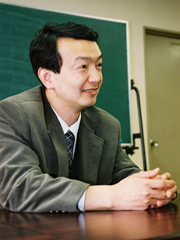Profiles and Activities
Profile
|
|
||||||||||||||||
Courses In Charge
| Mechanism |
|---|
| Although apparent motion of a machine looks intricately, you can recognize that it is the combination of simple principles after careful observation. Various elements of mechanisms such as a gear, a link, a cam are proposed and used widely in industrial application. This lecture aims at understanding the technique and principle to analyze the movement of mechanisms from theoretical and application point of view. |
| Mechatronics |
| Various technologies are used in a robot. The broad knowledge and practical skills are required to realize a robot, such as fundamental components like sensors and actuators, and systematization technique to unify them. This lecture aims at understanding the basic matters of the fundamental components for a robot, and systematization technology. |
Main Research
| Our research goal is to develop human symbiotic robots which can support human’s daily life with sharing time and space with human. Various new problems will arise if a robot comes into a life of people. For example, the most intelligible thing is safety. Although one of the best solutions for making a robot safe is to make generative force and speed small, the performance of robots will be restricted. How can we be compatible these two issues? Moreover, the robot technologies improve the performance and functionality of various machines drastically even if they have not had a so-called robots’ form. For example, the muscles of animals and humans will move by stimulated electrically from the exterior. So it is realizable to row wheelchairs or bicycles by paralyzed extremities if we would be able to organize an electrical stimulation for it. Thus, the main subjects of our research are to develop new mobile symbiotic robots and application of robot technologies. |
| Development of Human Symbiotic Robots |
|---|
| A robot which works in people's life space needs various capabilities, such as coexistence of safety and high capacity for work, conversation, and understanding of human’s feeling. We are researching and developing various fundamental components and systematization technologies which are needed to realize those functions. The robot under development shown on the photograph is based on a peculiar concept which utilizes its own weight to perform tasks. |
| Development of Robotic Systems using Human Muscle as an actuator |
| Muscles of animals including humans are moving by the electric signal from a brain. If you have an electric stimulator outside of the body instead of the brain and it would generate appropriate stimulus, you can pedal a bicycle on foot even if you are lower limbs paralyzed with cord injury. Moreover, muscles are actuators with very high energy conversion efficiency. We are performing researches and developments to realize new robotic systems for human support using human’s muscle as an actuator. |
| Development Ultra-light-weight Robot Hand and Manipulator System |
| Although realization of the function equivalent to man's arm and hand is indispensable to realization of human symbiotic robots, these tend the most dangerous part of the robot. We are researching and developing an ultra-light-weight robot hand and arm system to cope with the coexistence of task capability and safety in collaboration with material and sensor/actuator researchers. |
Introduction of Laboratory
| Students assigned to our laboratory study knowledge required for graduation research using Japanese and English textbooks through a seminar which is held several times in a week. Moreover, they study practical technologies of robots through challenging a robot competition. There are 5 members (one professor, one researcher, one secretary, and two under graduate students) in our laboratory. As annual events of our laboratory, there are a spring cherry-blossom-viewing meeting and an ‘imoni-party’ in autumn, and these two events hold in a lively way jointly with some other laboratories every year. We believe that good teamwork produces good robots. All work and no play makes Jack a dull boy, and, of course, all play and no work makes Jack a mere toy. Join us and make excellent robots! |
Recent Writings, etc.
| 1. | SeongHee Jeong, Takayuki Takahashi, “Wheeled Inverted Pendulum Type Assistant Robot: Inverted Mobile, Standing, and Sitting Motions,” Proc. 2007 IEEE/RSJ International Conference on Intelligent Robots and Systems IROS, pp.1932-1937 2007. |
| 2. | Takayuki Takahashi, Ryosuke Takahashi, Jeong SeongHee, “Ultrasonic phased array sensor for an electric travel aids for visually impaired people,” Proc. The 2007 International Conference on Mechatronics and Information Technologies, 2007. |
| 3. | Takayuki Takahashi, SeongHee Jeong, et.al., "Robot joint using three dimentional cam," Applied to JPO 2007-144504. |


